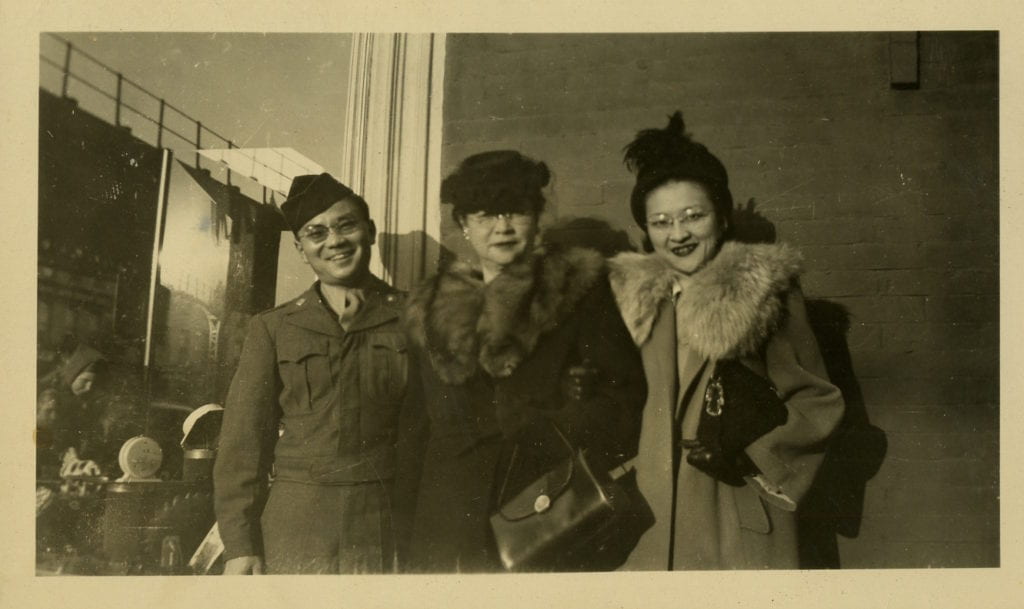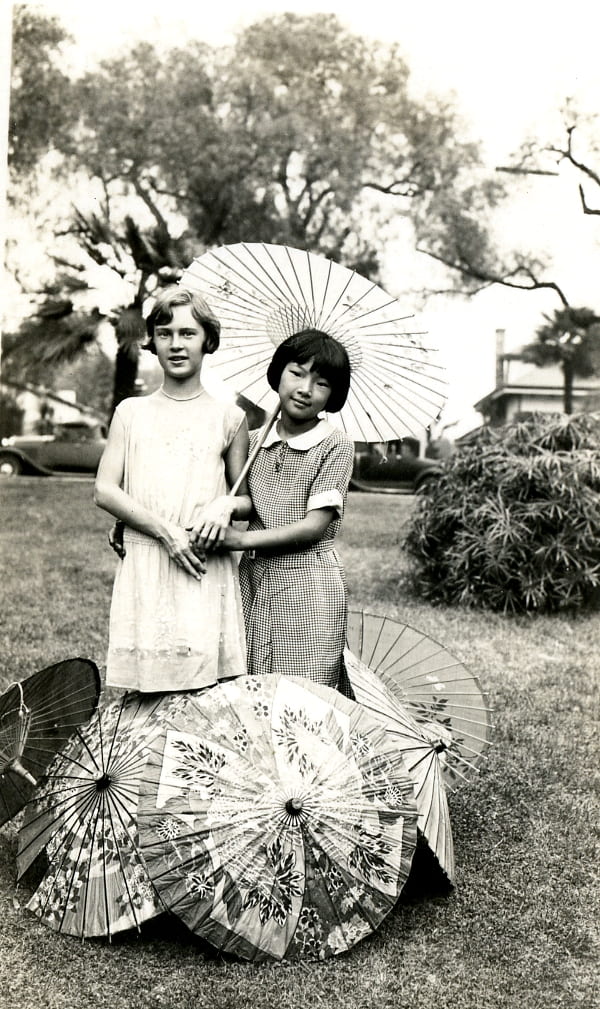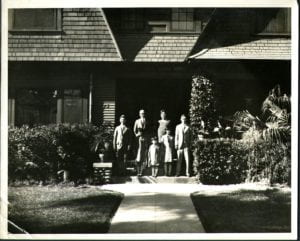Righting (and Writing) Wrongs: Reparative Description for Japanese American Wartime Incarceration
This post is written by Shannon O’Neill, Curator for Tamiment-Wagner Collections, and Rachel Searcy, Accessioning Archivist.

Photograph of Peter Hata, left (Midori’s husband), Shizue Shimanochi, middle, (mother), Mari, right (Midori’s sister); December 1946; Midori Shimanouchi Lederer Papers; TAM 596; box 1; folder 7; Tamiment Library/Robert F. Wagner Labor Archives, New York University.
Language evolves over time. Think about words or phrases that you once utilized that are no longer popular, or have since been critiqued as being harmful or offensive. You likely changed your usage of such words or phrases, and perhaps even cringe a bit when remembering things you used to say. Archivists, too, give consideration to the words we choose and words we (or our predecessors) have chosen over time. Archivists must think about our descriptive practices—inclusive of collection descriptions, finding aids, and catalog records—as iterative work and as an active process. It is our responsibility to describe individuals, groups, cultures, and subjects accurately. Accurate description means that the language we use is representative of how individuals, groups, organizations, and subjects describe themselves. It is language that is respectful, and it is language that aims to minimize, or repair, harm.

Photograph of two girls with umbrellas, undated; Midori Shimanouchi Lederer Papers; TAM 596; box 1; folder 5; Tamiment Library/Robert F. Wagner Labor Archives, New York University.
Recently in the course of accessioning—that is: analyzing, stabilizing, and documenting new archival materials upon their arrival—an addition to the Midori Shimanouchi Lederer Papers, archivist Rachel Searcy noticed euphemistic terms like internment and relocation were used in the collection’s finding aid to describe the experiences of Japanese Americans during World War II. These deliberate, bureaucratic euphemisms downplay the reality of state-sanctioned violence that Japanese Americans faced as a result of President Franklin D. Roosevelt’s Executive Order 9066. In contrast to this specious language, accurate vocabulary such as incarceration and forced removal better reflect the reality of these events. Rachel invited curator Shannon O’Neill into a collaborative research and remediation process to address this inaccurate and harmful language in the collection’s finding aid, which grew into a larger reparative description effort.
As archivists we are responsible for creating accurate description related to the experiences of Japanese Americans during this time period, and for repairing the hurt done through the presence of legacy description with harmful terminology. Ultimately, Japanese American advocacy groups have been doing this work for decades, and to honor and uphold this work we must move forward in ways that center their experiences. In our research process, we looked to the guidance and recommendations of the Japanese American community, inclusive of the Japanese American National Museum (JANM), National Japanese American Citizen League (JACL) Power of Words II Committee, and Denshō. Advocates and activists within the Japanese American community have produced abundant resources on correct terminology to describe the experience of Japanese American incarceration, such as the JACL’s Power of Words handbook. We also looked to the work of colleagues within our professional field who have taken on similar redescription efforts, and we consulted with our generous colleagues and community partners at NYU’s Asian/Pacific/American (A/P/A) Institute. Our reading, listening, conversations, and research offered us a clear pathway to reparative description.
Many of us learned about these injustices against Japanese American individuals, families, and businesses with the terms internment or internment camp. Internment has a legal, international definition documented in the Geneva Conventions that stipulates the conditions under which a warring country may incarcerate enemy soldiers or select civilians of an enemy power. The reality is that the majority of individuals who were removed from their homes and incarcerated during World War II were in fact American citizens. The term is simply not accurate, and incarceration more appropriately describes this experience. Instead of internment camp, we will use the term concentration camp (or American concentration camp). Power of Words describes a concentration camp as “a place where people are imprisoned not because of any crimes they committed, but simply because of who they are.” That is what happened to Japanese Americans during World War II. In the late 1990s the JANM created an exhibit called “America’s Concentration Camps” that was met with public controversy due to the title. We use concentration camp in solidarity with this linguistic intervention to disrupt and confront the erasure of State violence, and as such, will not acquiesce to less charged, and less accurate alternatives, such as incarceration camp or illegal detention center.
Similarly euphemistic terms like evacuation and relocation do not hold up under any serious scrutiny. Relocation suggests a voluntary move. What comes to mind when you think about people evacuating their homes? Probably a scenario like a hurricane or a wildfire where people need to leave in response to a serious, external threat for the sake of their own safety. Using this term falsely suggests that the presence of Japanese American lives alone constituted some kind of emergency or disaster. The incommensurable logic that one can both be the emergency or disaster that precipitates an evacuation, and have to be evacuated from that same emergency or disaster, reveals the inherent racism of the term’s usage in this particular context.
So how do we apply this knowledge, and an intention to repair harm, to our archival description? The following paragraph shows an excerpt of the biographical note from the Michi Kobi Papers before this redescription effort (bolding added for emphasis):
Michi Kobi (1924-2016), born Machiko Okamoto, was a Japanese American actress and activist. During World War II, she was sent to the Topaz War Relocation internment camp in Utah with other Americans of Japanese descent. She turned to acting while in the camp and after the war pursued an acting career in New York, appearing in film and Broadway productions. Kobi also worked to draw attention to the injustices of internment, and in 1980 served as the co-chairman of the East Coast Japanese Americans for Redress.
(Michi Kobi Papers, TAM 697; description written November 2016)
Distancing language, including the euphemistic terms we’ve discussed in this blog post, the passive voice with no named agent of responsibility, and generic terms like “the camp” impact how we understand Kobi’s experiences. The following paragraph shows our revision of the same excerpt:
Michi Kobi (1924-2016), born Machiko Okamoto, was a Japanese American actress and activist. During World War II, she, along with 110,000 other Nisei, was forcibly removed from her home and incarcerated at the Central Utah Relocation Center, a concentration camp (euphemistically referred to as an internment camp) in Topaz, Utah. She turned to acting while incarcerated and after the war pursued an acting career in New York, appearing in film and Broadway productions. Kobi also worked to draw attention to the injustices of Japanese American wartime incarceration, and in 1980 served as the co-chair of the East Coast Japanese Americans for Redress.
(Michi Kobi Papers, TAM 697; description revised September 2020)
This deliberate intervention into our legacy description recenters the lives of Japanese Americans by aligning with the Japanese American community’s wishes to describe its own past and present. It acts as a form of accountability by accurately naming the historical violence of the State and limiting the ongoing violence perpetrated through obfuscation of the truth.
As archivists, we have an ethical imperative to be transparent about our actions. Our work necessitates analytical sense-making and decision-making based on professional judgment, and is undoubtedly informed by our own biases and positionalities. Fostering an environment of transparency and the on-going nature of reparative work requires accountability to the communities who have been harmed. Accountability, simply put by anti-violence activists Kiyomi Fujikawa and Shannon Perez-Darby, is taking responsibility for one’s choices and the consequences of those choices. You can see the values of accountability and transparency made manifest in our work: we describe what we’ve done and why in a collection’s Processing Information Note (listed in the “Administrative Information” section of the finding aid), and we are starting to include links to the finding aid’s Github version history so users can see the changes that have taken place. Our local policy brief for how we address Japanese American wartime incarceration represented in our holdings codifies the descriptive decisions we’ve made and the reasons we made those decisions. While external community guidelines like Power of Words informed our decisions, this publicly-accessible document acts as an institutional commitment for us to maintain these interventions and pursue future redescription for other collections in a consistent manner.
We have more work to do—we always will. To ensure we are accountable to both the Japanese American community, and maintain our commitment to engage in this work, we are reviewing the entirety of our archival holdings to develop a list of collections that utilize harmful legacy description about Japanese American incarceration. Archivists in the Archival Collections Management (ACM) department will work through the entirety of this list and revise the description for each of these collections. We are also evaluating approaches to address the problematic Library of Congress Subject Heading Japanese Americans — Evacuation and Relocation, 1942-1945. This work is taking place within a broader effort to embed reparative and inclusive principles into our archival practices. A working group comprised of catalogers and archivists is examining strategies to request the Library of Congress changes its terminology for harmful subject and name headings, while also exploring ways to remediate the usage of these headings within our local practices, metadata, and access and display technologies. We also know that this is not the only place where the language in our finding aids does not accurately or respectfully represent the individuals or communities in our collections. We are committed to surfacing, addressing, and remediating harmful language across our archival collections. A team from ACM and Special Collections is developing a statement that both acknowledges this commitment and offers a process for corrective action.

Photograph of Shimanouchi family, likely in front of home in Fresno, California, undated; Midori Shimanouchi Lederer Papers; TAM 596; box 1; folder 7; Tamiment Library/Robert F. Wagner Labor Archives, New York University.
Language has meaning. As we work to repair the harm for events that took place decades ago, we are presently witnessing a similar debate play out on what to call immigration facilities on our southern borders. This is how certain narratives are shaped, disseminated, and enshrined. It is also how they can be dismantled: by rejecting terms that facilitate acts of injustice and obscure them from the public eye. Archivists have a role in the way that history is shaped, communicated, and made accessible. It’s imperative, then, that we approach our work with both care and cultural humility. As our professional colleague Jessica Tai offers, archivists can employ archival description that is community-centered. To do so, we must activate critical self-reflection, hold ourselves and our institutions accountable, and be cognizant of power imbalances that are both produced and reproduced in the archives. This reparative work can take many forms, and one action archivists can take is to remedy the use of oppressive language within our collection description.
Archivists, catalogers, and curators working in archives and special collections are actors who make decisions in, with, and about collections. These decisions have an impact on communities whose histories, and present-day lives, are documented within those collections. It is important that we therefore imbue our work with an ethic of care; that we acknowledge, as Michelle Caswell and Marika Cifor write, “that we are inextricably bound to one another through relationships, that we live in complex relations to each other infused with power differences and inequities, and that we care about each other’s well-being.” By embracing an iterative mindset, an ethic of care, and the concept of cultural humility into our work, we can support the revision and redescription of our collections—over time—in a way that is respectful and responsive to changes in language and the ways in which communities describe themselves.
References and Further Reading:
Caswell, Michelle, and Marika Cifor. “From Human Rights to Feminist Ethics: Radical Empathy in the Archives.” Archivaria 81 (May), 23-43. https://archivaria.ca/index.php/archivaria/article/view/13557.
Denshō. “American Concentration Camps.” Accessed September 10, 2020. Densho.org. https://densho.org/american-concentration-camps/
Faith Charlton, Kelly Bolding, Cate Peebles, Jennifer Garcon, Betts Coup. “Implementing Inclusive (Re)Description at Predominantly White Institutions.” Society of American Archivists Annual Meeting, 2020. https://archives2020.sched.com/event/dNmf/s24-implementing-inclusive-redescription-at-predominantly-white-institutions
Kuhelika Ghosh. “Redescription: Collections on Japanese American Incarceration.” Winter 2019. https://www.library.ucla.edu/sites/default/files/media/ucla_lsc-cfprt-Redescription.pdf
Japanese American Citizens League. Power of Words Handbook: A Guide to Language about Japanese Americans in World War II. 2013. https://manzanarcommittee.files.wordpress.com/2020/06/powerorwords-revised-jacl.pdf
Japanese American National Museum. “America’s Concentration Camps.” JAMN.org. Accessed September 10, 2020. http://www.janm.org/projects/clasc/map.htm
NPR. “This Isn’t The 1st Time Americans Have Debated What To Call Detention Centers.” NPR.org. Accessed September 16, 2020. https://www.npr.org/2019/07/05/739051933/this-isnt-the-first-time-americans-have-debated-what-to-call-detention-centers.
Tai, Jessica. “The Power of Words: Cultural Humility as a Framework for Anti- Oppressive Archival Description,” in “Radical Empathy in Archival Practice,” eds. Elvia Arroyo-Ramirez, Jasmine Jones, Shannon O’Neill, and Holly Smith. Special issue, Journal of Critical Library and Information Studies 3. https://journals.litwinbooks.com/index.php/jclis/article/view/120
Yoshinori H.T. Himel, “Americans’ Misuse of ‘Internment,’ Seattle Journal for Social Justice Volume 14, Issue 3 (Spring, 2016), https://digitalcommons.law.seattleu.edu/sjsj/vol14/iss3/12